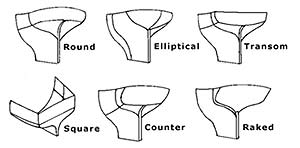| Terminology: |
|
|
Ballast; Heavy material, such as iron, lead, or stone, placed low in the hold to lower the centre of gravity and improve stability.
Barque or bark; A three masted, square rigged on the fore and main, and fore and aft rigged on the mizzen mast. Carvel Built; The method of covering a vessel's frame with planking or strakes laid edge to edge and secured to the frames with nails or treenails so as to form a smooth outer skin. Ceiling; The inside planks of a vessel. Floors, or Floor-timbers; The timbers that are fixed athwart the keel, and upon which the whole frame is erected. They generally extend as far forward as the fore-mast, and as far aft as the after square timber; and, sometimes, one or two cant-floors are added. Frames; The bends of timber which form the body of the ship, each of which is composed of one floor-timber, two or three futtocks, and a top-timber on each side; which being united together, form the frame. Of these frames or bends, that which incloses the greatest space is called the midship or main frame or bend. The arms of the floor-timber form a very obtuse angle; and, in the other frames, this angle decreases or gradually becomes sharper, fore and aft, with the middle line of the ship. Those floors which form the acute angles afore and abaft are called the rising-floors. Keel; A longitudinal timber, or series of timbers scarfed together, extending from stem to stern along the bottom of a vessel. It is the principal timber of the vessel, and, by means of the ribs attached on each side, supports the vessel's frame. In an iron vessel, a combination of plates supplies the place of the keel of a wooden ship. Outer Planking; Planks applied to the outside of a ship to cover its timbers. Wood much less in thickness than in breadth is called a plank. Schooner; A vessel with a minimum of two masts, fore-and-aft rigged on both. They are built carrying from two to five masts. Being fore-and-aft rigged, meant Schooners could "point up higher" or "work windward" to a greater degree than other vessels. These ships are also much more nimble and can move more easily off a lee shore. Sheathing; A thin sheet of copper or yellow metal laid, over the ship's bottom timbers, to protect the planks from worms and other foulings. Tar and hair, or brown paper dipped in tar and oil, may be laid between the sheathing and the bottom. Square Stern; Basic stern types include; round, elliptical, counter, square transom and raked transom. As illustrated (after McKee, 1983) |
 |
|
Trunnel or Treenail; Cylindrical oak (typically) pins driven through the planks and timbers of a vessel to fasten or connect them together. These fastenings were best when driven through, and caulked or wedged inside. Ideally made from the very best oak split out near the butt, and perfectly dried or well seasoned. |